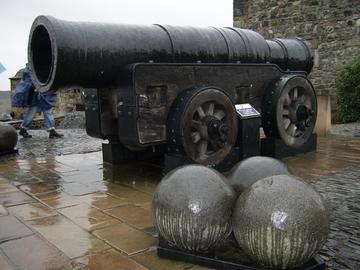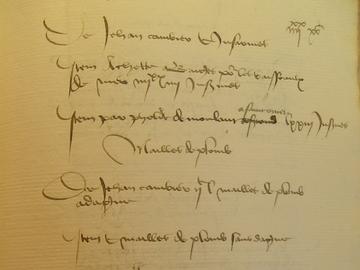The Cambier Arms Business as Military Entrepreneurship Avant-la-Lettre in the 15th Century Low Countries

Mons Meg, wrought-iron bombard bought by Philip the Good, duke of Burgundy, from Jean Cambier, dealer in artillery, 1449. Edinburgh Castle.
Mons Meg, currently preserved and displayed at Edinburgh Castle, is certainly one of the most iconic late medieval guns. A 1454 gift of Philip the Good, duke of Burgundy, to James II, king of Scots, this impressive wrought-iron bombard weighing almost 7 tons has spurred the imagination and research of generations of amateurs and historians alike. The technological history of this gun has been examined thoroughly: it consists of an iron powder chamber and iron reinforcing circles layered around longitudinally aligned bars to form an explosion-resistant and solidly welded barrel. However, beyond technological prowess and diplomatic exchange, the gun also tells another story: that of military entrepreneurs from Hainault in present-day Belgium, the Cambier family, at the height of their business success when the gun was first bought by Philip in 1449. Yet, its gift to James II, only five years later, already announced their subsequent demise as their wrought-iron merchandise was quickly becoming outdated.
The Cambier story is one of military entrepreneurship avant-la-lettre curtailed by the development of state-led industries for gunpowder weaponry. Hence, it prefigures challenges raised by, and unsatisfactory responses to, the increasing demands for military supplies to growing dynastic armies. These challenges would be essential to the emergence of the Early Modern contractor state as the latter opted to significantly outsource both levies of manpower and production of materials in the context of a European-wide fiscal-military system. As Pepijn Brandon, Marjolein ‘t Hart and Rafael Torres Sanchez highlighted for the 18th century (2018), military entrepreneurship should not be defined too narrowly. It encompasses a wide range of (usually) private investments in resources needed for (usually) public warfare. These resources, or “assets” as defined in our Fiscal-Military System ERC-project, include credit, manpower, materials, and information. Often considered an Early Modern phenomenon, diversified and large-scale military entrepreneurship is, however, already apparent in the Cambier family’s commercial activities in the mid-15th century. Along with a limited number of other merchants, the Cambier business did indeed provide for the Burgundian dynastic state’s military needs, reaching an almost monopolistic position as a supplier of artillery-related materials.
Jean Cambier has usually been considered the artisan responsible for Mons Meg’s confection. Closer examination of Burgundian source material and its precise terminology, however, leaves no doubt about Cambier’s principal quality as a financier and military entrepreneur. Originally a gunsmith, he quickly became known as a dealer in arms (marchand d’artillerie). Significantly, he is never referred to as a gunner, gunsmith, or gun-founder (canonnier, canonnier et forgeron, canonnier fondeur). Moreover, the amplitude of his supplies to the Burgundian army would be impressive for a single late medieval workshop in the metallurgical sector. Appearing in Burgundian sources in the 1440s, he was regularly contracted by the Burgundian dynastic state to supply guns from 1443 onwards. In February 1448, for instance, a contract committed him to deliver no less than 111 small-calibre crapaudeaux, an unknown number of middle-calibre fowlers, and a bombard. In 1453, he delivered another 59 wrought-iron culverins (small handheld firearms) and, the next year, was paid for 2 bombards, 15 fowlers, 129 crapaudeaux and 87 culverins.
Undoubtedly, Cambier would not have been able to produce all these guns himself, even with the help of a few apprentices and companions. Although he may originally have had his own workshop to forge or supervise production of these guns, their quantity and diversity suggests that he was outsourcing at least a large part of the ducal orders to other gunsmiths. Private business papers have not been preserved, but it seems highly likely that Cambier called upon the well-developed metallurgic industry in the county of Hainault’s centres such as Mons, where he resided, and Valenciennes, both towns widely renowned for their gun-production in the 15th century.
Moreover, Cambier came to act as a middleman to equip the Burgundian army with all sorts of gear related to the metallurgic industry. In 1453, for example, he delivered 1,200 dozen war-arrows, but also 200 iron spades, 200 drain spades, 100 axes, 100 billhooks, 100 crowbars, and 1,000 leaden mallets. In 1454, another 26,300 iron-tipped crossbow quarrels alone were delivered to the ducal arsenal.
Well-rooted in metallurgical enterprise, Cambier’s business activities progressively expanded to other areas. At least in terms of Burgundian army supplies, they were still related to gunpowder artillery. Regularly, stone cannonballs were provided in addition to the guns. This ammunition was easily sourced in nearby Hainault centres of stone production, especially the quarries of Écaussinnes. Although not processing them himself, Cambier also bought and delivered large quantities of ingredients for gunpowder: hence, among other sales in 1451 and 1453, he sold 1,142 pounds of saltpetre, 2,000 pounds of sulphur, and 1,200 pounds of charcoal to the duke. Whereas charcoal was locally produced and used in the metallurgic industry, sulphur and saltpetre arrived through the international port of Bruges, where the Cambiers could also have accessed credit on the financial market. To what extent they were able to profit from the latter is still unclear, as family roots and other ties to local and regional networks in the Low Countries remain to be investigated.

A few deliveries by Jean Cambier, attested in the ducal artillery book held by controller Berthelot Lambin, 1439-1451. Dijon, Archives départementales de la Côte-d’Or, Série B, n°11866, f°95 (detail)
In any case, in the early to mid-1450s, the Cambier business was at its height as successive wars against Ghent (1450-53) and in the bishopric of Utrecht (1456) created high demand for military material for the princely army. In 1455, Pierre Cambier, likely Jean’s son and still referred to as Pierot (little Pierre, an indicator of his young age), delivered 60 iron culverins alongside 60 longbows, 1,836 dozen arrows, 1,254 dozen iron arrowheads, 780 pounds of saltpetre, and 500 pounds of charcoal to the ducal army. Business was thriving.
However, the fall of princely demand during a decade of relative peace (1456-65), the replacement of wrought-iron guns by bronze guns, and the rise to power of Charles the Bold, a prince desiring to modernize the ducal artillery through state-led production, all triggered the decline of the Cambier business, “father & son”, as military entrepreneurs. Indeed, as Charles the Bold sought to increase mobility and fire-rates to improve efficiency on the theatre of war, retained or semi-retained gun-founders obeyed clear specifications to produce new standardised types and calibres. Sometimes cast in foundries established and funded by the dynastic state, these new guns were to replace the huge variety of wrought-iron guns produced in the largely uncontrolled Hainault smithies. From the mid-1460s onwards, Pierre Cambier, son and successor to Jean, found it increasingly hard to sell his merchandise and almost entirely disappeared from the Burgundian documentary evidence. Significantly, his reappearance in 1475, is only testimony to his vain efforts to convince the ducal counsellors to buy a series of courtauds and serpentines, guns of a new type which Charles the Bold had ordered his ducal gun-founders to produce in bronze. Cambier’s merchandise, however, was still in wrought-iron. Although reimbursed for his efforts, including transportation of the guns to show them at the court, Cambier was kindly turned away. Whether this changed context led to bankruptcy of the Cambier business or just forced them to target other clients, for instance towns and noblemen still actively involved in warfare in the Low Countries, is, at present, still unknown.
In different ways, the story of the Cambier business prefigures later military entrepreneurship. Of course, Jean Cambier was no Louis de Geer or Elias Trip, let alone a Basil Zaharoff. Increasing army sizes and their systematic provisioning by the state, as well as new means of transport and communication, would considerably enlarge both the quantitative and geographical scale of such entrepreneurship. Nevertheless, the Cambier story already highlights an urban network linking finance and strategic materials located in an international port to a web of metallurgic industry producing firearms and other military equipment in its hinterland, a network similar (and partly the direct ancestor) to the one on which Amsterdam would rely in the 17th century. Moreover, the Cambiers’ decline illustrates an essential tension between outsourcing and state industries. Only when the State became powerful enough to enforce its specifications on the internal arms industry through legislation, and hence to steer the market, would outsourcing become as desirable as state-led production. In the Low Countries, this was achieved to a certain degree under Charles V, and more thoroughly, by the Dutch Republic’s army supplies at the end of the 16th century. Finally, the Cambiers illustrate how dangerous it could be to rely on the demand from one partner, a reliance which later military entrepreneurs as de Geer or Zaharoff overcame by broadening the scope of their business beyond the borders of their home polity.
Michael Depreter is Research Associate for The European Fiscal-Military System 1530-1870, and focuses on the Amsterdam case study.


